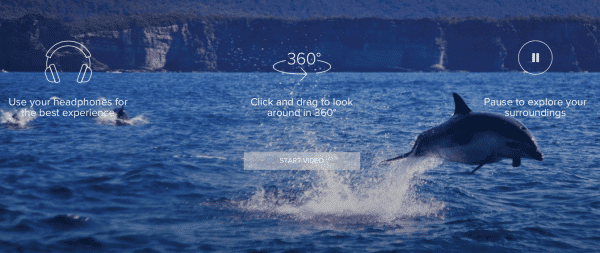
13 Content Marketing Trends You Need to Follow
Content marketing is always changing. It’s not something you set up and forget, especially in an age when all marketing is going digital. Content has become the essence of branding, lead generation, and even sales campaigns, across inbound and paid channels, primarily due to one thing: its effectiveness.
With more access to data and a better understanding of your buyers’ preferences, you may always be fine-tuning your approach to content marketing.
For those looking for what’s in, what’s working, and what’s next, we’re sharing emerging trends in content marketing that have increased in popularity of late. And how they relate to overall digital marketing trends as we head into next year. Learn why they matter and how you can apply them to your overall content marketing plan.
So here are the top content marketing trends you need to follow next year:
- Personalized Content
- Brands Go Niche with Content
- Voice Search Will Evolve How Content Marketing Sounds
- Content Needs to Be Concise, Not TL;DR
- Diversified Content Brings in New Audiences
- UGC Continues to Rock
- Influencer Marketing Is Evolving
- Embracing Live Video
- Interactive Content
- The Written Word Speaks Louder
- Automated Content Creation
- AI-Powered Content Marketing Strategy
- Focus on Content Experience
Trend #1: Personalized Content
With a savvier customer, you need a more sophisticated way to communicate, one that speaks to that person on an individual level. It matters because expectations have changed and being relevant to what a buyer wants to know is key.
Personalization offers you an edge against the competition, too. The data supports this — a study by Demand Gen found a 20% increase in sales opportunities when brands use personalized lead nurturing.
Personalization depends almost completely on data. So, the more data you have about your customers, the better the chance to create more meaningful messaging. You’ll need to decide what type of information you need, including demographics, priorities, preferences, objections, and how they use what you offer.
You won’t start with much data. If you get a lead to give you a name and email address for one piece of content, that’s a start. Additional data can be found through third party sources, plus you’ll know which topic interested the prospect.
With a name, email address and content topic, create a campaign that offers those that fit this parameter additional relevant content via email. Then you’ll be able to track if they open the email and what links they click on. The more they interact with your brand, the more personalization you can include.
PS – I put together these 10 tips for optimizing your content marketing. Watch Now!
Trend #2: Brands Go Niche with Content
No matter what vertical you are in, there is probably content saturation. This means that most of the companies in that industry are publishing similar content. It will only get harder to increase your organic ranking for certain keywords.
To address this and stand out, some brands are going very niche with their content to draw in a more specific buyer. Finding this niche usually involves combining a service you do well or a well-performing product and a specific industry. Instead of just writing about reasons for outsourcing app development, write about why healthcare should outsource app development.
This is one of the many reasons why our clients are betting big on employee activation. You have employees who love cats? Let them write about cats. You have employees who like to play dungeons and dragons? There’s probably buyers out there just like them who like cats and playing some D&D. Of course you probably have some product engineers and customers service or sales people who love your space and want to create thought leadership too.
Celebrate the diversity of your employees and the stories they tell!
PS – Check out our weekly blog content service to grow your website traffic and leads!
Trend #3: Voice Search Will Evolve How Content Marketing Sounds
Screenless search is something that millions do every day. They simply ask their digital assistant a question without needing to look at a smartphone or PC. Voice search accounts for at least 20% of all searching and is growing.

This will cause a shift in content because how we speak is not always in alignment with how we write. You’ll want to take time to adapt content to natural language search, which means including questions and answers.
To write in this style, include complete, full-sentence questions. Use longtail keywords in titles and headers. To take advantage of “near me” searches, optimize the natural language of the pages or posts you rank for with these search terms.
Trend #4: Content Needs to Be Concise, Not TL;DR
The average number of words in blog posts has been going up while the world’s attention keeps going down. Longer content does perform well in organic, but even if the page ranks on the first page of a search engine, will users stick around to read it? While this content is important, you can’t expect long content to be the right size for every buyer, especially those connecting with your brand on social media.
Short content works better for millennials, the generation with the most buyers. Another Demand Gen study found that millennials prefer videos and infographics for making decisions over other types of content. These formats are colorful, tell a story, and include movement.
The best way to leverage this trend is to use more video and infographics on social media and in channels where targeting the millennial demographic. Repurpose some of your blogs, ebooks or whitepapers as inspiration for new content.
Trend #5: Diversified Content Brings in New Audiences
Users will get bored if you only put up one type of content. That’s just not how things work anymore. Instead, the expectation is for your site to make use of different types of media, be it infographics, galleries, video, podcast or something else.
Yes, this does mean that you’ve got to diversify your skill set (and possibly your team’s) but it does bring some advantages along with it as well. If you diversify how you present your content, you won’t need to do quite as much work creating new content. Quite often, taking content that has proven successful in one medium can be put in a new jacket, updated and then shown again in another media form.
The reason this works so well is because most users have a preferred way to consume media. They might prefer video, audio or text. That means they will naturally select themselves into different groups, which means the vast majority won’t even notice that they’ve already seen that media before. Even those that do won’t mind so much, as you’ve got new ideas and are presenting information in a new way.
Trend #6: UGC Continues to Rock
UGC has become the mainstay of ecommerce content marketing. Here’s an impressive statistic: 85% of people trust content made by other users. That’s a lot and that is something that you want to take advantage of. How do you do that? By creating the potential for your users to create their own content to share on your site.
This has a huge number of advantages.
- As long as it is largely positive, it will impress new arrivals.
- It will give your users the feeling that they’re being listened to and heard.
- It will create a community.
- It will give you content for free!
In other words, it is an awesome way to draw you audience deeper into your website, by giving them new content that they are particularly interested in and particularly likely to trust. What’s more, once people have discussions and relationships going on the website that you’re running, they’ll come back to see their friends and hear what they’ve got to say.
This is a strategy that Harley Davidson used to lethal effect and has weathered every storm that came their way because of it. Why not take a page from their book and apply the same system to your content marketing campaign?
https://www.instagram.com/p/Bz-u758hSJ9/
Trend #7: Influencer Marketing Is Evolving
Influencer marketing has been a source of great results for brands. That social proof is so critical for buyers. They rely on it much more than any other influencing factors. In fact, Nielsen found that 92% of buyers trust an individual recommendation over the brand.
The crux of influencer marketing will remain the same. The difference will be in how brands use it. Brands now seem to be shifting from quantity to quality. Whereas, it may have been the general thinking to get as many endorsements as possible in the past. Now it should be about the quality and the trustworthiness of the influencer.
To change up your influencer marketing, you’ll need to determine the criteria for an influencer to work with your brand. Then create a campaign targeting these influencers to get their attention. Continue to do this and grow the relationship with those that respond. Track your data once you have influencers involved in campaigns to ensure the investment is worthwhile.
Trend #8: Embracing Live Video
It’s clear that brands are using video in content marketing. Millions of videos are made every day about just about any topic imaginable. Videos aren’t new, but live video is a sub-category that’s working for some brands.
With live video, there’s still the chance that what happens next could be unscripted. Live video makes a lot of sense when your brand is out and about in the world. Live stream from your booth at a trade show. Or, show something from the field if that’s applicable to your brand. Live video offers you unique possibilities that are very engaging.
These are only a few of the content marketing trends that will continue to build throughout the rest of the year into next year. These trends don’t represent huge changes. They do represent clear ways to improve your content marketing so you can attract the leads and new business you’re working to secure.
PS – Check out our latest case study that shows how we helped one company double their leads!
Trend #9: Interactive Content
With so much content and so little time, coupled with shorter attention span, it’s becoming harder and harder to reach and engage today’s consumers. This is why some brands are turning to interactive content to make a lasting impression on their target audience and to drive more engagement.
Interactive content, at its core, drives two-way conversations, and allows the audience to actively participate in the content rather than passively consuming it as with static content. Content types like quizzes, tests, calculators, polls or surveys allow consumers to gain tailored results or insights on a topic they care about or a challenge or problem they are facing. VR is also charging the marketing scene as the next best way to engage and entertain viewers.
When content is interactive users have fun in the process of viewing and interacting with the piece of content. When you successfully engage visitors, you can gather valuable insights from their behavior on your website to help educated your lead generation and website optimizations later on.
Tourism Australia’s official website, for example, uses a variety of compelling interactive content to better engage potential tourists and convert. Its series of 360-degree virtual reality video tours, which can be watched with a VR headset, allows individuals to truly immerse themselves and virtually experience various stunning adventure spots in Australia, from swimming with whale sharks to climbing up the country’s highest building SkyPoint Climb for its breathtaking view of the Gold Coast.

Trend #10: The Written Word Speaks Louder
Sure, Snapchat and Instagram are all cool and exciting, but for the most part, content marketing still relies on the written word. The problem that has become glaringly obvious to anyone who wants to pay attention is that the writing is often poor, to say the least.
Most marketers were simply never trained in the fine art-slash-science of writing. Expecting them to do exceptional writing is the same as expecting them to know how to do amazing illustrations or write a theme tune.
This is why this might actually be the year when the technical aspects of writing finally get recognized as important and when online writing and blog management services finally get the attention they deserve.
Trend #11: Automated Content Creation
Many marketers are looking for new and more effective ways to create content beyond their freelancers. We may begin to see marketers producing content through robotic algorithms soon, as these technologies continue to improve and become more sophisticated. We’re starting to see automated algorithms creating simple content for a wide range of industries, including journalism and finance.
New software will soon be available to help marketers compile and create new content from all the information shared by social media users around the world. We saw this with Twitter’s Project Lightning, which creates new stories based on the images, posts, videos and other content people share in their tweets.
Trend #12: AI-Powered Content Marketing Strategy
AI-driven content marketing maybe be the biggest and most game-changing trend yet.
Search algorithm changes mean more importance is placed on long-form content and semantic search. Google’s Knowledge Graph, for example, is helping search users pull up better results for their long-term search queries. Google is taking this to the next level by using AI to facilitate better matches to search queries using its RankBrain algorithm.
What will we do when the AI tells us what to create and where to distribute it? That future may be closer than you think!
Trend #13: Focus on Content Experience
Keeping up with your customer preferences and trends can be exhausting, but it’s well worth it. Consumers will only pay attention to your content if it’s convenient for them. They won’t read a blog page littered with pop-up ads or a video that loads horribly on their browser.
Content experience is the way your content is presented to viewers, from the page it lives on to the way it engages viewers. To succeed in this area, you need to tailor your content experience to your target audience. When done successfully you will increase engagement, customer loyalty and overall interactions!
Start Creating!
The main takeaway here is that content marketing is here to stay. Start experimenting with different trends within your own content marketing strategy.
Do you need help kickstarting your company’s content marketing efforts? You’ve found yourself in the right place. Check out our content builder services or schedule a free consultation today!







Great piece Michael I absolutely agree with you. Content marketing is not set and forget anymore. A few years back it was about getting your website ranked in google but now its not that simple anymore.
Now we can live which is indeed very powerful for some brands, but I feel at the same time it is important to understand what you are good at, trying to be everywhere can be exhausting at times (I am guilty of it).
Absolutely Anoop, thanks for sharing your insights. Content marketing has changed and we have to change with it but it is certainly much more work to be as consistent and dynamic as we have to be now.